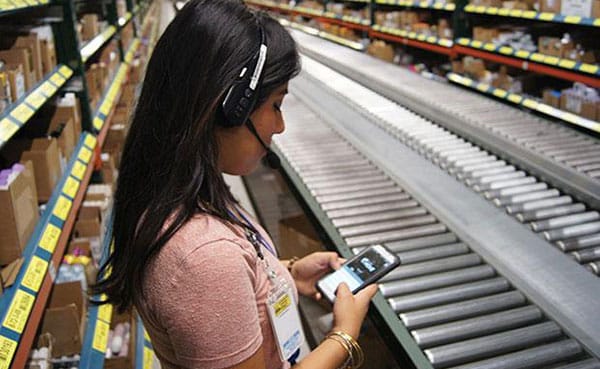On a global scale, warehouse space may have never been more in demand or as scarce as we see today, thanks to the compounding effects of eCommerce growth, pandemic shutdowns, rapid manufacturing, and changing consumer habits. That means you’ve got to squeeze as much usable space out of your existing facility as possible if you optimize that ROI.
The capacity crunch has many companies thinking about adding storage space without physically building out more square footage — not only is construction difficult, but those materials are costly now. To help, we’ve put together a few considerations that can work in most warehouses and other storage spaces.
Go vertical
Ask any warehouse professional how to improve space utilization, and they’ll tell you to look up and see how much wasted space exists above existing pallets and racking. While the most common answer, it’s almost always the best place to start. Investigate the space you have and see what you can do with it, whether that’s adding more racking, changing storage media, or reorganizing pallets to optimize picking clearance and shelving.The right choice depends on your products and physical space. With cubic storage models becoming the new standard, automation can not only save space but also reduce costs per item.
In some cases, this change is simple. Looking for larger carton flow racks, for example, allow you to stack goods higher while still ensuring you follow FIFO principles. Advanced carousel systems can increase the number of bins in any vertical section. Automated models further add space by limiting picker access to specific points, reducing row space within the carousel to increase overall bin numbers. This can also assist with batch picking to speed up overall order fulfillment in many cases.
You have a chance to compound these gains, too. Advanced slotting and picking technologies can help you go vertical and reduce worker travel through intelligent SKU grouping. Some models and combinations can increase productivity by up to 40%.
Optimize aisles, traffic, and pallets
The racking itself is another solid area of focus for expanding warehouse space. The two chief considerations here are aisle width between racks and how much access pickers have. Let’s start with aisle width.
Say your current aisles are spaced 12 feet apart and allow for two-way traffic. Pickers can move independently but sometimes get stuck or slowed when someone using a pallet jack or forklift is working in the same area and moving in the opposite direction. You need to ensure there’s space for two carts or jacks. Narrowing this down to eight feet (some even go a few feet smaller) and making aisles one-way can reduce the walking space you require. Multiply that across your entire warehouse, and you can quickly end up with more storage square footage and fewer bottlenecks.
When pickers do need extra room or support, such as requiring reach trucks, adjust space for that equipment. Spaces that already require a reach truck can often switch to deeper racks to accommodate more inventory in existing space. Drive-through racks further reduce the spacing needed for aisles. With pallets loaded onto horizontal rails, you also pick faster and fully utilize space up against walls.
Analyze your space
The trick to getting these changes correct is to thoroughly analyze and map your space, order volume, pickers, and SKU requirements. Each places constraints on what’s available but also gives you opportunities. Analytics tools that help you layout your warehouse, optimize picking routes, and direct put-away can all identify options for better space utilization.
Machine learning tools have come a long way, and there are many partners specializing in this for different types of goods. Red Stag Fulfillment, for example, specializes in bulky and heavy items. While this minimizes our ability to use automated conveyors or robotic picking arms, many tools help us optimize product locations and space utilization for forklifts. Fire up every tool at your disposal to see what’s in reach.
Look for applications that offer returns designed for today’s dynamic needs. Modern systems enable many traditional practices to be more flexible, allowing you to emphasize accuracy and productivity. For example, real-time slotting support reduces the physical space you need in your warehouse for products. You’re using available space without needing dedicated pallets or areas that end up holding air for part of the day. Directed picking orders and optimized routes ensure that these goods are still properly picked from dynamic slots, improving throughput and avoiding delays.
Empower cross-docking
When you can’t make more room, you’ve just got to use the existing space better. Cross-docking is an advanced inventory utilization technique that allows you to unload inbound shipments, scan them into inventory, and then load these same goods onto outbound trailers. You often increase your staging area near dock doors but skip the storage phases. This can enable you to have more room for slower moving inventory while still optimizing order space and speed.
The same real-time slotting technology can be applied here. This ensures teams are using the correct items and that your inventory counts stay accurate no matter how fast people move. Companies can up their cross-docking and standard picking efforts by adopting voice interfaces, which are shown to speed up picking and packing while reducing worker stress.
Balance people and products
The final note for seamlessly expanding your fulfillment center without adding square footage is a quick reminder. Test every suggestion and option that’s available before a complete implementation. Your warehouse, products, and people create a unique blend that not every tool can understand. Choose options that work well for your products and your people.
This ultimately means following 75% to 80% of the optimization advice you get in many cases. You can add vertical storage, replace racks, update pallets, and more. But at the end of the day, your people still need to safely, comfortably access every inch of the warehouse. Don’t push and optimize so much that they’re forced to squeeze between racks or near equipment, putting them at risk. The best space optimization is one that ensures a warehouse still operates with people as its focus.

Jake Rheude is the Vice President of Marketing for Red Stag Fulfillment, an eCommerce fulfillment warehouse that was born out of eCommerce. He has years of experience in eCommerce and business development. In his free time, Jake enjoys reading about business and sharing his own experience with others.





